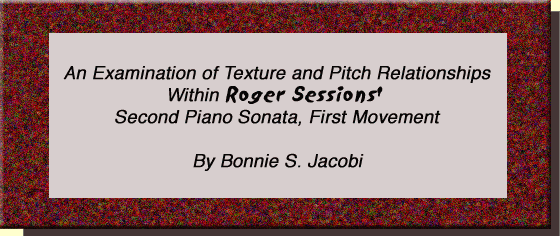

 |
This article originated as
a paper written for a Theory Seminar taught by Dr. Tim Koozin at the Universityof
Houston Moores School of Music. The paper has been adapted for the Web as a
part of a Music Technology Seminar (Spring 2000), also taught by Dr. Tim Koozin
at the Moores chool of Music. Bonnie S. Jacobi is a doctoral candidate in Music
Education.
In examining the first movement of Roger Sessions' Second Piano Sonata, both the pitch relationships and the texture of the music can be quite revealing of the form. Analysis of a difficult work such as this is helpful to a pianist who is learning to perform it. In his article "Twentieth-Century Analysis and Mozart Performance", Carl Schacter states, "every analysis is a kind of conceptualized performance, and every performance embodies an implicit analysis."1
Upon first
sight, a pianist may find this movement somewhat enigmatic. The traditional
structure of sonata-allegro form is not used, but rather a general ABA format.2 Traditional features such
as tonality, contrasting sections, breaks between sections, and recognizable
melodies are not easily identifiable. It does not seem to be a coincidence that
Sessions had an aversion to using specific terminology to describe his music.
In fact, he discouraged others from trying to label the sections. However, through
meticulous motivic design and careful notation of phrasing, dynamics and articulation,
Sessions has given this movement structure and shape.
Traditional features such
as tonality, contrasting sections, breaks between sections, and recognizable
melodies are not easily identifiable. It does not seem to be a coincidence that
Sessions had an aversion to using specific terminology to describe his music.
In fact, he discouraged others from trying to label the sections. However, through
meticulous motivic design and careful notation of phrasing, dynamics and articulation,
Sessions has given this movement structure and shape.
Using
set theory as a tool in determining the relationships between pitches, the main
motive (which will be referred to as the q motive) can be described as set type
[0,1,2,6].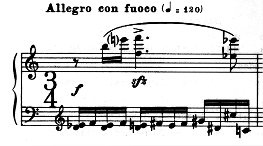
At the left, see Example 1, treble clef, for the q motive (Sessions, Second Sonata, Marks Music/Hal Leonard Publishing, 1976). It is stated twice in the treble clef during mm.1-2. Although this set type is repeated throughout the movement at different transposition levels (see mm.12-14 for example), it maintains the same general rhythm. This rhythm consists of a short rest on the downbeat, two sixteenth notes, a dotted or tied third note and a final eighth note. As a result, the set type can be recognized aurally as a melodic motive. The q motive is particularly exciting (see below) when heard in succession four times in mm.12-15 (each time it is transposed except for the third time when it is
presented
at the original pitch level.) However,
there are several occasions when the order of the pitches is scrambled such
as in m.141 and the set type is not audible. In this particular example, the
change of clefs hinders the familiarity of the set type, Another example is
in m.57, where the pitch order is not only scrambled, but the motivic rhythm
is compressed into four sixteenth notes. Whereas the rhythm in this example
disguises the q set type, the rhythm is more radically altered in mm.119-121.
This rhythm is heard earlier in mm.7-9 but now contains the q set type. Finally,
the q set motive example in mm.131-132 is latent in that it is written across
the bar line and uses interior notes.
However,
there are several occasions when the order of the pitches is scrambled such
as in m.141 and the set type is not audible. In this particular example, the
change of clefs hinders the familiarity of the set type, Another example is
in m.57, where the pitch order is not only scrambled, but the motivic rhythm
is compressed into four sixteenth notes. Whereas the rhythm in this example
disguises the q set type, the rhythm is more radically altered in mm.119-121.
This rhythm is heard earlier in mm.7-9 but now contains the q set type. Finally,
the q set motive example in mm.131-132 is latent in that it is written across
the bar line and uses interior notes.
One of the ways in which Sessions develops his idea of the main motive q is through expansion and compression. He creates derivatives which are either an expanded version of the main motive such as [0,1,2,7] in mm.16,21,31 and [0,1,3,6] in m.30, or a compressed version of the main motive such as [0,1,2,5] in mm.54, 62, 90, [0,1,2,4] in mm.41, 43, 49, 55-56, 77, 81-83, 85 and even [0,1,2,3] in mm.20, 28-29, 92-93, 114, and 164. Other set types used in the piece may also be regarded as distant or secondary derivatives of main motive q. For instance, [0,1,3,4] in m.11 could be related to [0,1,2,4] or [0,1,2,6] by a common trichord subset. Similarly, [0,1,3,5] in mm.22, 24, 36, and 44 could be related to [0,1,2,5] or [0,1,3,6].
Other set types which recur include [0,2,5,7] from the pentatonic scale and [0,2,4,6] from the whole tone scale. These two set types are also spun off into derivative sets (see [0,2,5,8] in mm.46, 110, 113 or [0,2,4,7] in mm.20, 22, 24, 36, etc.). Set type [0,2,6,8], which is located in m.10, also denotes the whole tone scale. It is set in contrary motion against set type [0,2,4,6] to create a unique whole tone effect.
(Click to hear Sound Example 1)
These derivatives of the main motive q are rarely used "thematical ly" in the same manner as q, but still they serve other important functions. Sometimes, these derivatives serve as accompanimental figures (i.e. [0,1,2,7] in m.31.) Other times, they serve to create a new melody (i.e. [0,1,2,7] in m.16. It is set type [0,1,2,3] which perhaps assumes the greatest importance during the course of the piece. Sessions uses this set strategically in mm.92-93; these two measures comprise the largest climax of the entire movement. (Click to hear Sound Example 2) It so happens that the rhythm of [0,1,2,3] here does resemble the main motive q. Similarly, Sessions uses this same set to end the movement with a built-in ritardando.
There are four
subsets of main motive q which can be found throughout the movement: [0,1,6],
[0,2,6], [0,1,5] and [0,1,2]. Three-note sets are used creatively by Sessions.
Compositionally, they are used to accommodate the mixed meter. Moreover, they
enable Sessions to repeat the rhythm of the q motive which begins with a rest
(see m.54). Perhaps the most extraordinary way in which Sessions uses a three-note
set can be seen at the right in m.66. 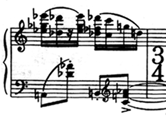 He
writes an octave with a third on the bottom, followed by another octave, returning
to the original octave/third. By layering these notes in such a manner, he achieves
a dense, bulky texture using only three pitches. This sound is consonant although
chromatic, whereas his layering of double octaves at a major second apart (mm.92-93)
is strikingly dissonant (seen below at left).
He
writes an octave with a third on the bottom, followed by another octave, returning
to the original octave/third. By layering these notes in such a manner, he achieves
a dense, bulky texture using only three pitches. This sound is consonant although
chromatic, whereas his layering of double octaves at a major second apart (mm.92-93)
is strikingly dissonant (seen below at left).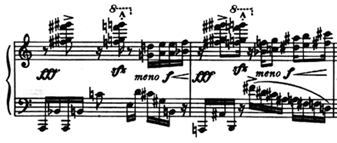
In addition to
the set types, changes in Sessions' writing style highlight important moments
within the movement. Overall, the writing in the first four pages of music is
linear (with the exception of a few thick chords in the right hand of mm.7-9.)
Each hand only plays one note at a time, although occasionally there are two
notes and in scattered places, there are chords with three notes. Suddenly however,
in m.62, there are four successive chords consisting of three notes each (see
below). The register is low for such thick chords. Further, Sessions uses the
staccato/tenuto marking for the first time in the movement. The following measures
are marked heavily with sforzandi and accents. 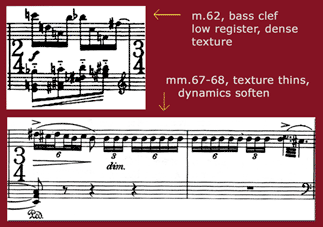 In
m.67, the sound diminishes, the texture thins; all that is heard is a portion
of the whole tone set type [0,2,4,6] and then pitch B. (Click
to hear Sound Example 3)The first
tremolo used in the movement occurs at the end of 69 on a subset of the q motive
[0,1,2]. One can consider this measure to be the end of the A "section."
In
m.67, the sound diminishes, the texture thins; all that is heard is a portion
of the whole tone set type [0,2,4,6] and then pitch B. (Click
to hear Sound Example 3)The first
tremolo used in the movement occurs at the end of 69 on a subset of the q motive
[0,1,2]. One can consider this measure to be the end of the A "section."
The B "section", beginning in m.69, starts in a similar manner to the opening of the A section. Once again, the q motive is heard, only this time the register is quite low. In fact, the opening pitch low B is the lowest pitch heard thus far in the movement. The tremolos continue and the sound soon thickens as both hands play chords stretching an octave or wider. This section offers contrast in that it reaches a dynamic height of fff and stays there for two measures. Quartal harmony is heard for the first time in the movement (mm.96-100.) The repeating octaves in mm.101-104 are reminiscient of the closing of the A section. Sessions increases the anticipation by delaying the return of the A section. The q motive is stated only in much expanded form (m.105-107); it has undergone a metamorphosis. The rallentando and Tempo I markings help to signify the return to the A section. This section is again linear, for the most part, with the exception of mm.155-160. Like the original A section, the staccato/tenuto markings, sforzandi and accents reappear.
Roger Sessions was a composer who struggled to notate his music. In the early years of his career, he refrained from writing specific indications for fear the performer would exaggerate the gesture.3 After hearing several "unmusical" performances of his works, he became frustrated and started to write more specific instructions to the performer. Written in 1946, the Second Piano Sonata contains precise instructions for tempo, phrasing, dynamics and articulation. Still in the performer's hands, however, is the difficult task of studying the design of the piece. There are set types that fit patterns and others which do not. In some ways, this work is more challenging to perform than a serial work, such as Sessions' Third Piano Sonata, because there is so much left for the performer to decide.
1 Carl Schacter, "Twentieth-Century Analysis and Mozart Performance," Early Music, (November 1991): 620.
2 Andrea Olmstead, Conversations With Roger Sessions, (Northeastern University Press, 1987): 80.
3 Olmstead: 83.